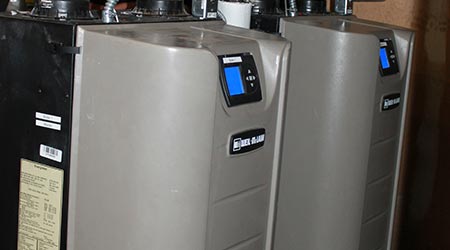view all Case Studies
Fabric Ducts Prove Key Solution in Arena Upgrade

The $72 million renovation of the 55-year-old, 70,000-square-foot Daniel-Meyer Coliseum at Texas Christian University presented many issues related to HVAC, specifically the roof's load-bearing limitations.
May 10, 2017 -
HVAC
The $72 million renovation of the 55-year-old, 70,000-square-foot Daniel-Meyer Coliseum at Texas Christian University's into the new Ed and Rae Schollmaier Arena presented many HVAC challenges.
The renovation included new locker rooms, expanded common areas and 140,000 square feet of building additions. Some of the design and installation challenges included:
· Limited indoor areas available for the new air handlers because design committee members discouraged roof placement on the renovation's new one-story build-outs for aesthetic reasons;
· Hanging new spiral metal air distribution duct from a bowl-shaped roof not originally intended for supporting the estimated 1,500-tons would require costly roof structural upgrades;
· Installing tons of 60-inch-diameter metal ductwork 47 feet high would be a jobsite safety concern for HVAC contractors;
· Strict year-round humidity and temperature tolerances were required to maintain the new wood basketball floor.
Fabric duct, which is 90 percent lighter than metal duct, was the solution to both the project's roof load-bearing limitations and a value engineering alternative to metal. However, the architecture committee was concerned with the deflated appearance associated with older style fabric duct during idle air handler periods. Recent industry developments of in-duct tensioning systems convinced the committee to use the FTS (Fabric Tensioning System) Jumbo Series from the SkeleCore product line manufactured by DuctSox Corp. SkeleCore is an in-duct, cylindrical metal framework tensioning system that's field-adjustable with a wrench for taut, wrinkle-free and inflated-like aesthetics regardless of air handler operation. The lightweight internal framework also has a minimal friction loss of only 0.04-inches w.g./100 feet.
Improvements in Air Comfort The arena's previous HVAC was provided by 26 indoor air handlers supplied with chilled water from an offsite central plant and hot water from onsite boilers in a basement pump room. Air handlers were evenly positioned inside the encircling mezzanine level corridor outside the seating area. The air handlers' plenum-supplied wall registers were positioned every 25-feet around the circular-shaped seating area's back wall. The design was state-of-the-art in 1961, however drafts near air discharge diffusers and inadequate return air draw through courtside grilles 100 feet away sometimes created an uncomfortable air environment. Thus, purge fire/safety exhaust fans were used to pull more air through the arena during heavily attended events.
Unlike the original back wall air distribution positions, the fabric duct ring hangs approximately 40 feet out from the back wall and disperses air more evenly throughout the seating and court areas. Air is dispersed through a linear array of laser vents that throw at three velocities of 150-fpm at 3-o'clock; 100-fpm at 4-o'clock and 9-o'clock; and 50-fpm at 8-o'clock. "The laser vents are capable of velocities that reach center court without the need of high-velocity nozzles," says Josh Schmidt, P.E., mechanical engineer and a member of Baird Hampton & Brown's design team. BHB is the consulting engineer/architecture firm which designed the HVAC portion of the renovation.
Space Restrictions for HVAC Units The renovation included build-out areas for concessions and the circular corridor's widening. With no ground space available and the existing build-out structurally incapable of HVAC unit loads, the new build-out's roofs were the only solution for the placement of three 50,000-cfm air handlers manufactured by York. While BHB would have preferred three symmetrical supply points at 3-o'clock 7-o'clock and 11-o'clock into the circular fabric supply duct for even airflow and low velocities, the build-out roofs' unsymmetrical positions around the arena permitted only air handler supply radius entry points of 10-o'clock, 8-o'clock and 4-o'clock in the circular duct design Therefore, airflow is designed to flow right or left, but not both directions, once entering the fabric duct ring via metal duct tee connections from the air handlers.
The York packaged systems also include coils for preheating outdoor air, reheating during the dehumidification cycle, cooling and electric humidifiers for maintaining strict wintertime relative humidity levels required by the basketball court flooring manufacturer. The strict environmental tolerances are monitored and controlled by the campus-wide Metasys building automation system (BAS) manufactured by Johnson Controls.
Other equipment specified includes an additional 6-MBH condensing boiler manufactured by Aerco International, to accommodate the building's added space requirements and to supplement three existing 2-MBH condensing boilers. All pumps were replaced because of age. A new hydronic strategy of redundancy with two 50-hp chilled water pumps and two 25-hp hot water pumps and two 10-hp general water pumps was incorporated.
"One major project challenge was keeping the existing pumps and boilers on line during the renovation to maintain services to the arena complex's many connected buildings depending on the original facilities hydronics," said Schmidt.
The lowering of the playing court four feet for better stadium seating views, plus adding locker rooms and other sublevel spaces, also allowed BHB to design more courtside return air, which feeds an existing concrete return air shaft. The shaft feeds a plenum above the encircling concourse that supplies the York units, which mix it with outdoor air as per data from the arena's CO2 sensors and the BAS.
Next
Read next on FacilitiesNet












